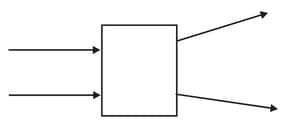Match Column I with Column II
Column I
Column II
(A) Relative speed
(P) Concave lens
(B) Undeviated passage
(Q) Convex lens
(C) Divergence of rays
(R) Refractive Index
(D) Converging lens
(S) Ray through optical centre
Important Questions on Light – Reflection and Refraction
The following diagram shows the use of an optical device to perform an experiment of light.

As per the arrangement shown, the optical device is likely to be a _____.
A converging lens forms a three times magnified image of an object, which can be taken on a screen. If the focal length of the lens is , then the distance of the object from the lens is _____.
If a lens can converge the sun rays at a point away from its optical centre, the power of this lens is _____.
An object is placed at a distance in front of a convex lens of focal length .
(i) Calculate the distance of the image from the lens.
(ii) Calculate the magnification of the image.
Which of the following statements is true?
A student wants to obtain magnified image of an object AB as on a screen. Which one of the following arrangements shows the correct position of AB for him/her to be successful?
A person can not clearly see objects at a distance more than 40 cm. He is advised to use lens of power
A virtual, diminished image is formed when an object is placed between the optical centre and the principal focus of a lens.
(i) Name the type of lens which forms the above image.
(ii) Draw a ray diagram to show the formation of the image with the above stated characteristics.

